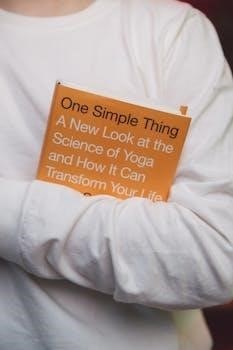clockwork orange pdf book
Anthony Burgess’s dystopian satirical novel, A Clockwork Orange, published in 1962, explores a near-future society plagued by youth violence. The narrative follows Alex, a teenage protagonist, as he navigates a world of extreme brutality and attempts at state-led reformation.
Overview of the Novel
A Clockwork Orange, a 1962 novel by Anthony Burgess, presents a chilling vision of a near-future dystopian society. The story is narrated by Alex, a teenage delinquent who leads a gang of “droogs” in acts of extreme violence. The novel is structured into three parts, each comprising seven chapters, reflecting a theme of human maturity. Burgess’s work delves into themes of free will, societal control, and the nature of good and evil, exploring the consequences of attempts to manipulate human behavior. The book follows Alex’s journey from brutal criminal to a subject of state-sponsored aversion therapy and ultimately to a point of reflection. The novel challenges readers to question the boundaries of morality and the purpose of punishment and rehabilitation. It is a provocative exploration of the human condition, set against a backdrop of futuristic slang and unsettling scenarios. The narrative is both thought-provoking and disturbing, leaving a lasting impact on its readers. The book is known for its unique use of the invented slang “Nadsat.”
Publication Details and Initial Reception
A Clockwork Orange was initially published by Heinemann in the UK on May 14, 1962, in a limited edition of 6,000 copies. Despite positive reviews from critics like Julian Mitchell and Kingsley Amis, the novel did not achieve immediate commercial success. Its provocative themes and use of Nadsat, a fictional slang, initially hindered its broad appeal. The book’s unconventional structure, divided into three sections of seven chapters each, also contributed to its unique identity. However, over time, it garnered significant attention and became a subject of widespread discussion. The novel’s exploration of violence, free will, and societal control sparked debates and controversies, solidifying its place as a significant literary work; It eventually found a larger audience due to the later film adaptation and its exploration of complex moral issues. The novel’s enduring presence in literary discourse highlights its profound impact despite a modest start and initial reception.

Content and Themes
The novel delves into a dystopian world characterized by extreme youth violence and societal control. Key themes include the nature of free will, the ethics of behavior modification, and the impact of violence on individuals and society.
Dystopian Setting and Youth Subculture
A Clockwork Orange presents a chillingly depicted near-future society where violence is endemic, especially among the youth. The setting is a grim, urban landscape, reflective of societal decay and moral bankruptcy. This backdrop acts as a breeding ground for the “droogs,” young gangs like Alex’s, who engage in acts of “ultra-violence” with disturbing casualness. The novel’s futuristic environment isn’t just about technological advances but rather showcases the degeneration of social structures. The youth subculture is characterized by its own unique slang, “Nadsat,” which further isolates them from the rest of society. This slang acts as a barrier, enhancing their rebellious and alienated status. The dystopian setting highlights a world where traditional values have eroded, leading to the rise of these violent subcultures. The state’s attempts to control these youths, paradoxically, often result in even more disturbing outcomes. The environment serves as a mirror, reflecting the potential consequences of societal apathy and the failure of conventional methods of control, creating a bleak vision of the future.
Alex’s Character and Narrative
Alex, the teenage protagonist of A Clockwork Orange, serves as a complex and deeply unsettling character. He is a charismatic but brutal leader of a gang, reveling in acts of violence and cruelty. The novel is presented through his first-person perspective, which offers an intimate yet disturbing look into his thoughts and motivations. Alex’s use of “Nadsat,” a unique slang, further defines his character, acting as a linguistic barrier between him and the reader. He is not just a villain but also a product of his environment, showcasing the blurred lines between individual agency and societal influence. Despite his heinous actions, Alex’s narrative often elicits a strange form of empathy, challenging the reader to confront the complexities of morality. His journey from a violent delinquent to a subject of state-sanctioned psychological reprogramming highlights the ethical dilemmas at the heart of the story. The narrative, through Alex’s voice, explores themes of free will, the nature of good and evil, and the dehumanizing potential of both violence and enforced conformity, presenting a character that is both repulsive and strangely compelling.
Themes of Violence and Free Will
A Clockwork Orange delves deeply into the themes of violence and free will, presenting them as intrinsically linked elements of the human condition. The novel depicts graphic acts of “ultra-violence” perpetrated by Alex and his “droogs,” forcing readers to confront the brutal reality of human depravity. This violence is not merely gratuitous; it serves to explore the boundaries of individual choice and the ethical implications of societal attempts to control it. The Ludovico Technique, a form of aversion therapy, is a central element, raising critical questions about whether removing a person’s capacity for violence also eliminates their freedom to choose good. The novel suggests that true morality arises from conscious choices, not from externally imposed behavior modification. By stripping Alex of his free will, the state transforms him into a “clockwork orange,” an automaton that appears harmless but lacks genuine humanity. This exploration of manipulated behavior underscores the delicate balance between individual liberty and social order, challenging the notion that violence can be eradicated through the suppression of free will.

The Film Adaptation
Stanley Kubrick’s 1971 film adaptation of A Clockwork Orange brought the controversial novel to the big screen. The film’s striking visuals and unsettling themes caused considerable debate upon its release, amplifying the book’s impact.
Stanley Kubrick’s Film Adaptation
Stanley Kubrick’s 1971 film adaptation of A Clockwork Orange is a cinematic masterpiece, renowned for its striking visuals and disturbing exploration of violence and social control. Kubrick’s vision brought Anthony Burgess’s dystopian world to life with unsettling precision, using a combination of stylized set design, unsettling music, and Malcolm McDowell’s unforgettable performance as Alex. The film’s graphic depiction of violence and its exploration of moral ambiguity sparked controversy upon release, contributing to its status as a cult classic. Kubrick’s adaptation is noted for its use of unsettling imagery and its exploration of themes such as free will, morality, and the nature of evil. The film’s impact on popular culture is undeniable, and it continues to be a subject of critical discussion and analysis for its artistic merit and its complex themes. It captures the essence of Burgess’s novel while adding a unique visual and atmospheric interpretation that has solidified its place in cinematic history. The film is a powerful and unsettling experience that challenges viewers to confront uncomfortable truths about society and human nature.
Differences Between Book and Film
While Stanley Kubrick’s film adaptation of A Clockwork Orange closely follows the narrative of Anthony Burgess’s novel, several key differences exist between the two. One significant distinction lies in the ending. The novel features a final chapter, which was omitted from the American release of the book and the film. This concluding chapter sees Alex, the protagonist, experiencing a change of heart and a return to normalcy, suggesting a potential for redemption. The film, however, ends with a more ambiguous note, leaving Alex’s fate uncertain and offering a less optimistic outlook on the possibility of genuine reform. The film also amplifies the visual aspects of Burgess’s dystopian world, using its unique cinematic language to emphasize its themes. Additionally, while both the book and the film explore themes of violence and free will, they often do so with different nuances and emphasis. The film can be argued to present a more disturbing and cynical view, while the book has a more literary approach, allowing for a deeper exploration of Alex’s psyche and the societal forces that shape him. These differences contribute to the separate and equally compelling legacies of the novel and its film counterpart.

Literary and Cultural Impact
A Clockwork Orange has significantly impacted literature, music, and visual culture. The novel’s exploration of violence, free will, and social conditioning continues to resonate, inspiring various artistic interpretations and scholarly analyses across different mediums.
Influence on Literature and Music
A Clockwork Orange has exerted a profound influence on both literature and music since its publication. The novel’s distinctive style, blending dystopian themes with a unique narrative voice, has inspired numerous authors to explore similar themes of social control and individual rebellion. Its impact can be seen in works that delve into the complexities of violence, morality, and the power of the state. The use of Nadsat, the invented teenage slang, added a unique linguistic dimension that has been imitated and referenced in various literary works.
Musically, A Clockwork Orange has been a source of inspiration for artists across genres. The novel’s dark and unsettling atmosphere has been translated into various musical compositions, and its themes of societal decay and rebellion have resonated with musicians exploring similar concepts. The use of classical music in Stanley Kubrick’s film adaptation further cemented the novel’s influence on the musical landscape, creating a lasting connection between the story and its sonic interpretation. The novel’s exploration of the human psyche and the consequences of violence continues to inspire creativity in both literary and musical contexts, making it an enduring source of artistic influence.
The Use of Nadsat Slang
One of the most distinctive features of A Clockwork Orange is its innovative use of Nadsat, a fictional teenage slang created by Anthony Burgess. This unique linguistic element adds a layer of complexity and otherness to the narrative, immersing readers in the world of Alex and his “droogs;” Nadsat is a hybrid language, blending elements of Russian, Cockney rhyming slang, and other influences, creating a vocabulary that is both familiar and alien. Words like “horrorshow,” “droog,” and “moloko” have become iconic, instantly recognizable as part of the novel’s distinct world.
The use of Nadsat serves multiple purposes in the novel. It acts as a barrier, separating Alex and his gang from mainstream society, creating a sense of exclusivity and rebellion. The slang also provides insight into the characters’ inner thoughts and emotions, revealing their violent tendencies and distorted moral compass. Furthermore, Nadsat contributes to the novel’s dystopian atmosphere, highlighting the breakdown of communication and the disintegration of traditional values. This unique linguistic creation has made a lasting impact on both literary and popular culture, becoming synonymous with the novel itself and a testament to Burgess’s linguistic inventiveness.

Availability and Editions
A Clockwork Orange has seen various editions, including British and American versions, with some textual differences. The novel is accessible in print, ebook, and PDF formats, allowing readers to experience Burgess’s work.
British and American Editions
The publication history of A Clockwork Orange is marked by notable differences between its British and American editions. The original British edition, published by Heinemann in 1962, presented the novel in its entirety, divided into three sections of seven chapters each, totaling twenty-one chapters. This structure was intentional, as Burgess saw the number twenty-one as symbolic of human maturity. However, the American edition, published later, omitted the final chapter, altering the book’s overall message and leaving the protagonist, Alex, in a state of less clear resolution. This significant change was not authorized by Burgess and was reportedly done to align the ending more with a sense of societal condemnation rather than potential redemption. The absence of the twenty-first chapter in the American version has been a source of critical discussion and debate, with many arguing that it fundamentally alters the novel’s intended meaning and thematic exploration. These differences highlight the challenges of publishing across different cultural contexts and the impact that such editorial decisions can have on a work of literature.
Accessing the PDF Book
Finding a digital copy of A Clockwork Orange in PDF format is relatively straightforward, given its popularity and widespread availability. Many online resources offer the book as a downloadable PDF file, often free of charge, catering to readers who prefer digital formats. These sources include platforms such as the Internet Archive, which hosts various editions and versions of the novel, allowing readers to access both the original British text and, in some cases, the altered American version. Additionally, some educational websites and digital libraries provide PDF copies as part of their collections, making it easy for students and researchers to use the book for academic purposes. However, it is essential to be mindful of the source when downloading, as some sites may not offer the complete, unaltered text or might pose security risks. Reputable platforms and libraries are the safest options for ensuring access to a reliable and accurate PDF version of A Clockwork Orange. Furthermore, some digital reading apps and platforms also make the book available in PDF format, often as part of their subscription services or ebook collections.

